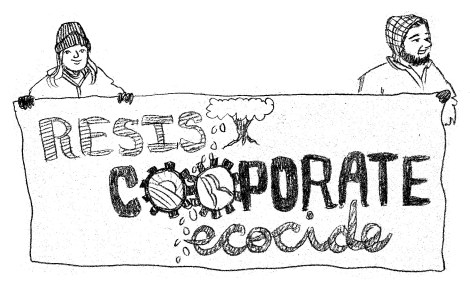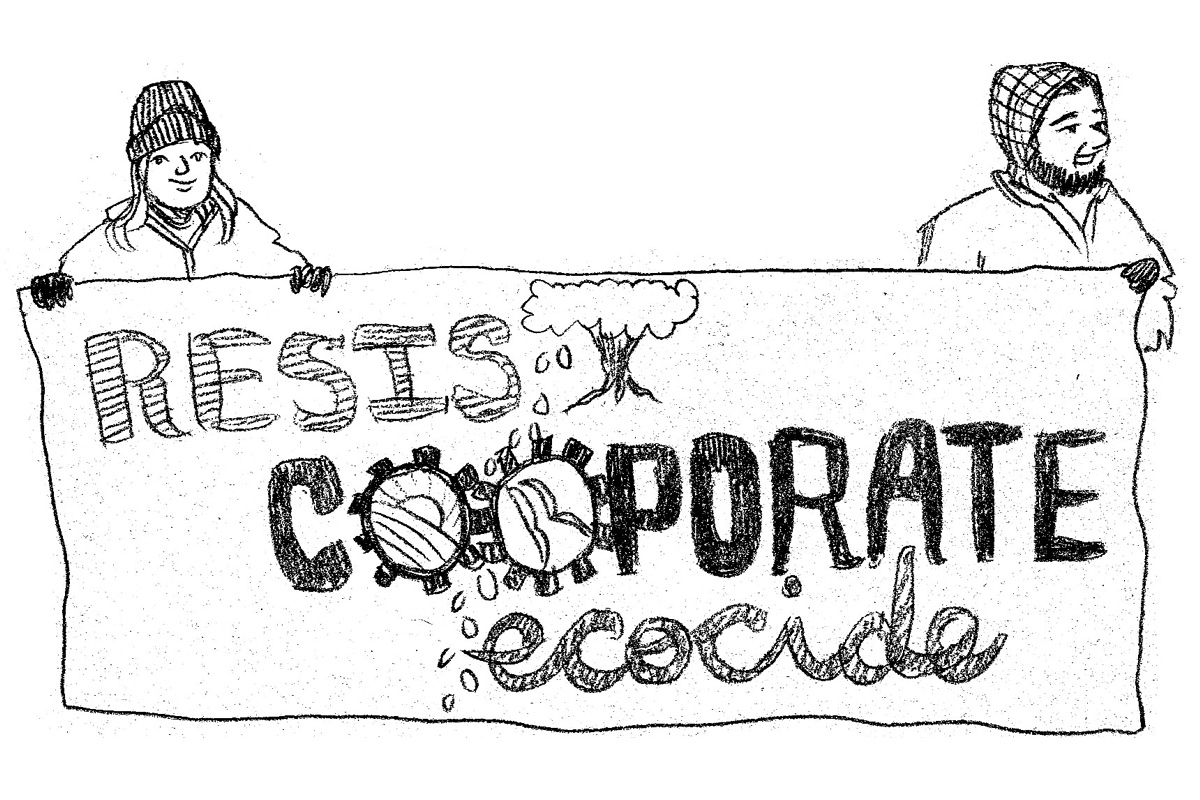 In front of the White House early Sunday afternoon, a young man deftly scaled a small leafless tree, to the shock and dismay of the older activists around him. One police officer suggested that he come down, which he eventually did — only to be yelled at by a woman who said he’d damaged not only the tree but the entire climate movement.
In front of the White House early Sunday afternoon, a young man deftly scaled a small leafless tree, to the shock and dismay of the older activists around him. One police officer suggested that he come down, which he eventually did — only to be yelled at by a woman who said he’d damaged not only the tree but the entire climate movement.
“But you’re not letting us talk,” he told her. “It’s just all about you.”
“What’s going to happen when everyone marches and then everyone goes home? There needs to be something more than that,” the tree-climber, Max, of Washington, D.C., told me afterward.
This little altercation defined a tension I saw throughout the Forward on Climate rally Sunday: Climate change reformists and climate change radicals allied tentatively, uncomfortably, against a crazy warming world. When one calls for the largest climate rally in U.S. history, one cannot really control who shows up and what their protest tactics and goals might be. Reform, or revolt? Coax, or prod? Organic, pesticide-free carrot or sustainably harvested, renewable stick?
“The concept that Obama is our friend and he’s going to help us is ridiculous. He is the enemy, by all accounts,” said Max’s friend Josh. (Both men declined to give their last names.)
“We shouldn’t be approaching him and saying, ‘We support you in your change.’ We should be approaching him and saying, ‘You fucking start this change or we’re going to do it ourselves,'” said Max. “We’re going to take over and cross this fence and walk over to that White House.”
The logo of the Forward on Climate event itself, a play on Obama’s own campaign logo, defined the thrust of the day. The star on Sunday was not actually the reviled Keystone XL pipeline but the absent president, and the carefully permitted and monitored rally did not have the character of a protest movement. “The march today looked like the movement that elected President Obama,” 350.org’s Jamie Henn wrote on Sunday. Many of the marchers would doubtless agree — but at least some would resent the comparison.
It’s notable that this rally was well separated from the 48 planned arrests that took place on Wednesday, the first action of civil disobedience that the Sierra Club had ever endorsed in its 120-year history. That was the radical act to Sunday’s reformist one. (A sidenote: For all my snarking about celebrities, they are super great for civil disobedience — since getting arrested is less likely to limit their employability!)
“We’re all just being really quiet, and timid. Our marching definitely says something, but I wish that we could be louder,” said Michael Vee from Massachusetts. “There’s power in the people, but ultimately it’s up to what [Obama] does. So there is this kind of disconnect insofar as how much we’re actually going to be able to do.”

“We need to use any nonviolent means necessary,” said Rebuild the Dream’s Van Jones. I asked him what he saw as the role of Sunday’s event.

“What can a rally do? I don’t know, what did the March on Washington do? People say, what can civil disobedience do? I don’t know, what did the Freedom Riders do? What did the sit-in movement in the ’60s do? People say, well what can students calling for divestment do? I don’t know, ask Nelson Mandela, because that’s what broke the back of apartheid. I don’t know what these things can do in particular but I know that in general these are the tactics that people have used around the world for hundreds of years and have made more history doing that, often, than the things that are considered normal politics, like running people you like for office and hoping they do a good job.”
A mass rally like Sunday’s has the potential to move the political center — to make climate activism and marching on the White House truly mainstream. But it also has the potential to undercut itself.
“You can’t move the center from the center,” climate activist/convicted felon Tim DeChristopher said in an interview at Orion in 2011. “If you want to shift the balance — if you want to tilt that scale — you have to go to the edge and push.”
DeChristopher was speaking for the radical contingent I saw out in numbers on Sunday demanding broader changes to the system — and making it clear they were willing to put their bodies on the line to make that happen. But to many at the rally, simply marching through D.C. spoke loudly and radically enough.
 “At this late hour in the climate crisis, with the clock ticking down on civilization, to be serious about climate change — based, mind you, on what science and not ideology prescribes — is to be radical,” Wen Stephenson wrote at The Boston Phoenix last week. As others have as well, Stephenson compares the climate movement to the movement to abolish slavery more than 150 years ago: A movement which struck hard and with a particular moral clarity at the very basis of the global economy.
“At this late hour in the climate crisis, with the clock ticking down on civilization, to be serious about climate change — based, mind you, on what science and not ideology prescribes — is to be radical,” Wen Stephenson wrote at The Boston Phoenix last week. As others have as well, Stephenson compares the climate movement to the movement to abolish slavery more than 150 years ago: A movement which struck hard and with a particular moral clarity at the very basis of the global economy.
It’s a flattering comparison, really: Who doesn’t want to think they’re fighting slavery? And who doesn’t want to think that we will win?
But it’s also useful to compare at least some aspects of this modern climate movement to a much younger, less successful, and less bloody movement that tried to bring together both revolutionaries and reformers: Occupy.
 Aside from police repression, that movement faced many of its own demons. It began with a tremendous urgency, anger, and joy. But in trying to rein in its extremists and hold onto its moderates, the movement arguably frustrated and alienated both camps. Ultimately activists ended up dedicating at least as much time to their own internal politics as their external ones. Meanwhile, pundits and pols chastised the movement for not having explicit policy demands. It was a teaching moment in the limitations of big-tent peoples’ movements.
Aside from police repression, that movement faced many of its own demons. It began with a tremendous urgency, anger, and joy. But in trying to rein in its extremists and hold onto its moderates, the movement arguably frustrated and alienated both camps. Ultimately activists ended up dedicating at least as much time to their own internal politics as their external ones. Meanwhile, pundits and pols chastised the movement for not having explicit policy demands. It was a teaching moment in the limitations of big-tent peoples’ movements.
While today’s climate movement has found a single rallying point for now — stopping the Keystone XL pipeline — it also encompasses a host of related issues. Folks on Sunday rallied against everything from factory farms to fracking to GMO foods, and they offered more urgent grievances than easy political solutions.
“[A]s any number of seasoned activists will tell you, it’s not Tim DeChristopher’s or the climate movement’s job to offer detailed policy prescriptions that fit within the confines of our current politics,” writes Stephenson. “The movement’s job is to tell the truth, however extreme — and to force those in power to recognize that even the outer limit of what our current politics will allow (a modest carbon tax, for example) is utterly inadequate to the crisis.”
To some extent, it takes all kinds and all tactics, a diversity of politics, policies, and approaches to make change. Every progressive political movement embraces that principle of coalition-building. It’s enticing to try to stand together under one big tent, to feel the energy of tens of thousands of people in the streets. But can there be escalation without alienation? Can there be a movement which allies interests, but doesn’t erase differences? And can that movement accept a radical vanguard, even held at a cautious distance?
In August 2011, Bill McKibben and more than 1,000 others were arrested, and some held for days, for peaceful civil disobedience against the tar-sands pipeline. “It’s not the easiest thing on earth for law-abiding folk to come risk arrest,” McKibben wrote after the ordeal.
Sunday’s rally saw many times that number take to the streets, but they weren’t risking much beyond their personal warmth. If the movement is to keep pushing forward, it needs to keep taking those risks. That may not be easy, but it’s likely to be necessary. And I can tell you that I know of at least one young man who is eager to join in — so long as he gets to climb a tree.
Correction: We’ve corrected the number of protesters arrested in August 2011, which this post originally misstated.




